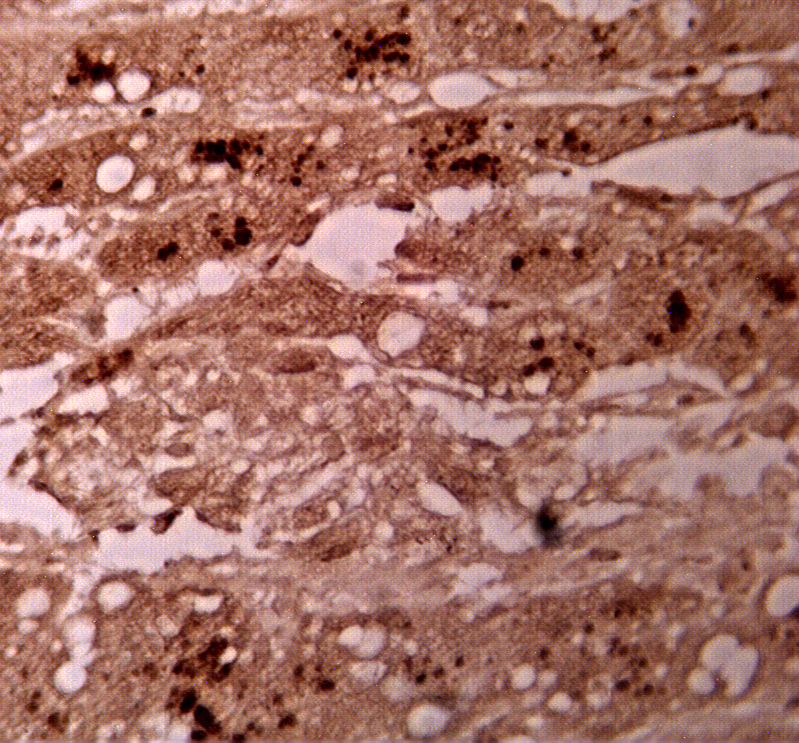Catalogue

Sheep anti Human Glypican-3 (GPC3)
Catalog number: X2395P| Isotype | IgG |
| Product Type |
Polyclonal Antibody |
| Units | 500 µg |
| Host | Sheep |
| Species Reactivity |
Human |
| Application |
Immunohistochemistry (paraffin) Western Blotting |
Background
Glypican-3 encodes a putative extracellular proteoglycan that is inferred to play an important role in growth control in embryonic mesodermal tissues in which it is selectively expressed. It appears to form a complex with insulin-like growth factor and hence modulate IGF2 action. Glypican-3 is the human homolog of OCI-5, a GPI-linked proteoglycan first isolated from rat intestine. Originally identified as the molecular basis for Simpson-Golabi-Behmel syndrome (SGBS) also called Simpson dysmorphia syndrome (SDYS).
Synonyms: GPC3, GPC-3, OCI5, OCI-5, GTR2-2, MXR7
Source
Immunogen: C terminal recombinant protein (~70aa) which does not overlap with clone 1G12 epitope)
Product
Product Form: Unconjugated
Formulation: Provided as solution in phosphate buffered saline with 0.08% sodium azide
Purification Method: Total IgG
Concentration: See vial for concentration
Applications
Antibody can be used for immunohistochemistry on paraffin-embedded tissues (10 µg/ml) and Western blotting (5-10 µg/ml). Optimal concentration should be evaluated by serial dilutions.
Functional Analysis: Immunohistochemistry
Storage
Product should be stored at -20°C. Aliquot to avoid freeze/thaw cycles
Product Stability: See expiration date on vial
Shipping Conditions: Ship at ambient temperature, freeze upon arrival
Caution
This product is intended FOR RESEARCH USE ONLY, and FOR TESTS IN VITRO, not for use in diagnostic or therapeutic procedures involving humans or animals. It may contain hazardous ingredients. Please refer to the Safety Data Sheets (SDS) for additional information and proper handling procedures. Dispose product remainders according to local regulations.This datasheet is as accurate as reasonably achievable, but Nordic-MUbio accepts no liability for any inaccuracies or omissions in this information.
References
1. Lai, J.P., et al. Sulfatase 2 up-regulates glypican 3, promotes fibroblast growth factor signaling, and decreases survival in hepatocellular carcinoma. Hepatology 2008, 47, 1211-1222.
2. Zynger, D.L., et al. Expression of glypican 3 in ovarian and extragonadal germ cell tumors. Am. J. Clin. Pathol. 2008, 130, 224-230.
3. Anatelli, F., et al. Value of glypican 3 immunostaining in the diagnosis of hepatocellular carcinoma on needle biopsy. Am. J. Clin. Pathol. 2008, 130, 219-223.
4. Yamanaka, K., et al. Immunohistochemical study of glypican 3 in thyroid cancer. Oncology 2007, 73, 389-394.
5. Filmus, J., et al. Glypicans. Genome Biol. 2008, 9, 224.
6. Baumhoer, D., et al. Glypican 3 expression in human nonneoplastic, preneoplastic, and neoplastic tissues: a tissue microarray analysis of 4,387 tissue samples. Am. J. Clin. Pathol. 2008, 129, 899-906.
7. Capurro, M.I., et al. Glypican-3 inhibits Hedgehog signaling during development by competing with patched for Hedgehog binding. Dev. Cell 2008, 14, 700-711.
8. Motomura, Y., et al. HLA-A2 and -A24-restricted glypican-3-derived peptide vaccine induces specific CTLs: preclinical study using mice. Int. J. Oncol. 2008, 32, 985-990.
9. Cheng, W., et al. Glypican-3-mediated oncogenesis involves the Insulin-like growth factor-signaling pathway. Carcinogenesis 2008, 29, 1319-1326.
Protein Reference(s)
Database Name: UniProt
Accession Number: P51654
Species Accession: Human
Safety Datasheet(s) for this product:
| NM_Sodium Azide |

" Immunohistochemical staining using GPC3 antibody (Cat. No. X2395P) on human hepatocellular carcinoma tissue. Antibody used at 10 µg/ml. Secondary antibody, HRP conjugated mouse anti-sheep (Cat. No. X1206M), used at 1:20 dilution. Sections heated for 10 minutes with 10 mM sodium citrate. "

